2014新目标英语八下U13a-3c
八 英语下册 Unit 1 Section A (3a-3c)
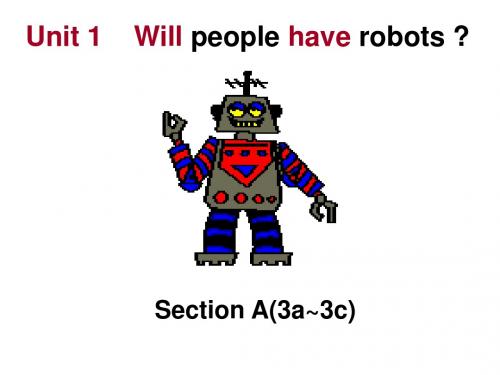
Will people have robots ?
Section A(3a~3c)
学习目标:
New words: building
Key phrase: in college, in five years Key sentences:
1)I think there will be more tall buildings.
短文填空
Nobody knows what will happen in the future. Maybe there’ll be_____ 1(更多) people but 2 __(更少) cars. Children will have 3___(更少) homework and 4 __(更 多) free time. They will study at home on computers, so there’ll be 5___ (更多) computers and 6___ (更少) teachers. You’ll see 7___ (少)factories but 8___ (更 多) trees. so there’ll be 9___ (更 少)Pollution. The word will be 10___ (更) beautiful.
2)What do you think Sally will be in five years? 3)I think she’ll be a doctor.
What will you be in 10 years ? I will be a … Where will you work? I will work in…..
Do a survey about your friends and finish the following chart.
八年级英语新目标下册 Unit1 SectionA 3a-3c reading课件分析
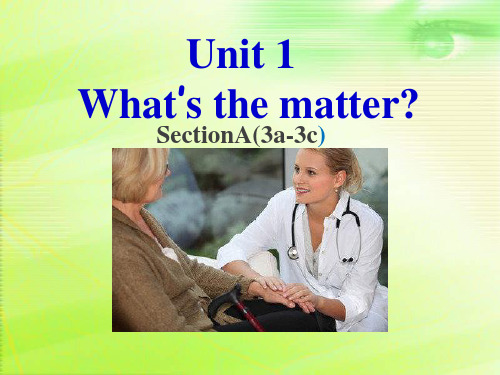
a.m. yesterday. 2.___Bus No.26 hit an old man on Zhonghua Road. 3._√__The old man had a heart problem and needed to
go to the hospital right away. 4.___The passengers on the bus didn't want to go to
3a-3c
Bus Driver and Passengers Save an Old Man
At 9:00 a.m. yesterday, bus No. 26 was going along Zhanghua Road when the driver saw an old man lying on t在he路si的de一o边f the road. A woman next to him was sho呼ut喊in帮g f忙or help. The bus driver, 24-year-old Wang Ping, stopped the bus withou不t 假th思in索king twice. He g下ot车off and asked the woman what happned. She said that the man had a heart problem and should go to the hospital.
人教版英语八年级下册 Unit1_SectionA(3a-3c)教案
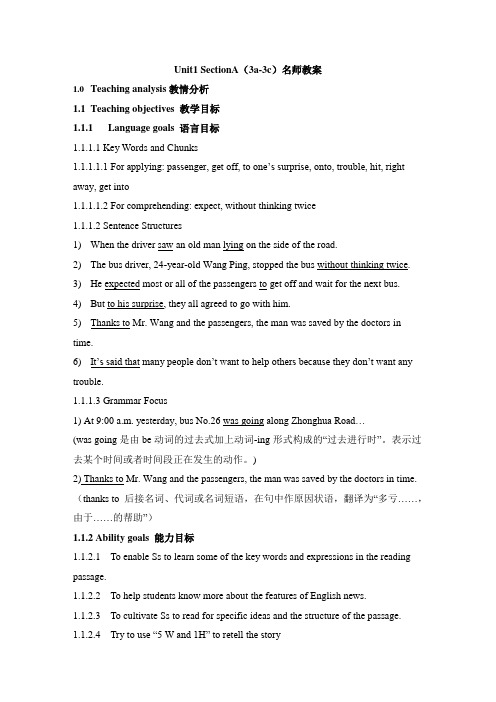
Unit1 SectionA(3a-3c)名师教案1.0Teaching analysis教情分析1.1Teaching objectives 教学目标1.1.1Language goals 语言目标1.1.1.1 Key Words and Chunks1.1.1.1.1 For applying: passenger, get off, to one’s surprise, onto, trouble, hit, right away, get into1.1.1.1.2 For comprehending: expect, without thinking twice1.1.1.2 Sentence Structures1)When the driver saw an old man lying on the side of the road.2)The bus driver, 24-year-old Wang Ping, stopped the bus without thinking twice.3)He expected most or all of the passengers to get off and wait for the next bus.4)But to his surprise, they all agreed to go with him.5)Thanks to Mr. Wang and the passengers, the man was saved by the doctors in time.6)It’s said that many people don’t want to help others because they don’t want any trouble.1.1.1.3 Grammar Focus1) At 9:00 a.m. yesterday, bus No.26 was going along Zhonghua Road…(was going是由be动词的过去式加上动词-ing形式构成的“过去进行时”。
八年级下册英语Unit1SectionA3a-3c教学课件
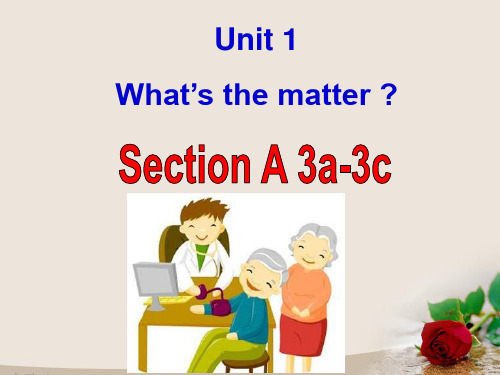
3a Read the passage and answer the following questions.
1. Do you think it comes from a newspaper or a book? How do you know?
√ and old man.
5 ____ Some passengers helped to get
√ the old man onto the bus.
6 ____ The old man got to the hospital in time.
3c Discuss the questions with a partner.
1. Why was Wang Ping surprised that the passengers agreed to go to the hospital with him?
2. Did the passengers think Wang Ping did the right thing? How do you know?
05 教学环节
教材分析
• 本课是新目标八年级下册第一单元 Section A 的阅读部分,它的任务不仅仅 是训练和提高阅读技能,也涵盖了实际交 际、词汇和知识点等内容,同时它还承载 着培养正确的情感态度、价值观等深层意 义,培养学生乐于助人的优良品质。教学 内容贴近学生生活,学生有一定的学习兴 趣。
expect he trouble think passenger
to
other think time
He e_x_p_ec_t_e_d most or all of the passengers to get off and wait for the next bus. But __to___ his surprise, they all agreed to go with him. Somepa_s_se_n_g_e_rshelped Mr. Wang to move the man onto the bus. T__ha_n_k_s to Mr.Wang and the passengers, the doctors saved the man in t_im__e_." It`s sad that many people don`t want to helpo_th_e_rs because they don`t want any _t_ro_u_b_le," says one passenger. "But the driver didn`t think about himself . He only t_h_o_ug_htabout saving a life.
人教新目标版英语八年级下册Unit1SectionA3a-3c课件
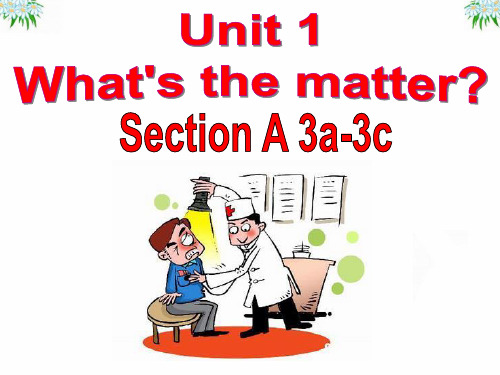
Fill in the blanks according to the story.
Wang Ping, a bus driver, was going __a_lo_n_g_ Zhonghua Road when he saw an old man __l_y_in_g_ the other side of the road. He stopped the bus without _t_h_in_k_i_n_g twice. He got off the bus and asked the woman next to the old man ____w_h_a_t__ happened. She said that the man had a heart ___p_r_o_b_l_e_m__ and should go to the hospital. Wang Ping told the passengers that he must ___t_a_k_e_ the man to the hospital.
没有多想
twice
twthwaeisTcdeshr.heiHovAbueeturtaaigs9nsggo:adgrr0twree0ofioeevfaafren.twamrh心,ooni2e.tldlye4ddph脏e-x.aoymspssteke病aebsarnectrdd-htloaytlysihdng,bbegeW2uwtt4osaoo在n岁oNnmfdtgoh路的fao去.Pe2nit6ss边nw医hitwgdeh,eas院atsbotofughpostaph下ipenedpg车retoanhaleoet(ddnob..g令AuSoZshnw某wheeooi人'smtnsahgi吃aodshnuuu惊ttnrhatpeha的Rxrtintio是tskhtaeoied)nhmgwimahnen h迅ad速a行hea动rt prtorboluemb期lea待n意d某为sh人o“做ul困d某g事难o Tto;htah麻nekh烦sost”poi.t时.a.l.多,M亏r是.…W不an可g k数ne名w h词e 。had to
2014人教新目标英语八下 unit 1《What’s the matter》period 1 section a (1a-1c)教案

Unit 1 What’s the matter?Period 1 Section A (1a-1c)Teaching Aims and Demands:1、Knowledge Object:(1) Ss can use the following words:head , ear, eye, mouth, nose, throat , neck, back, hand, arm, leg, tooth-teeth, foot-feet , matter, have a cold, stomachache, , backache, headache, toothache (2) Ss can use the following sentence patterns:What’s the matter?I have a stomache./I have a sore back./I have a cold.He/She has a sore throat.2、Ability Object:Enable students to talk about health problems using target language.3、Emotion Object:Let Ss know keeping healthy is important.Teaching Key Points:Learn how to talk about health, use have /has to talk about health problems Teaching Difficult Points:Learn the English names of different parts of human body and talk about various health problems.Teaching Methods:1. Listening and speaking practice.2 .Autonomous and cooperative approach.Teaching Aids:CAI, A tape recorder.Teaching Procedure:Step 1 Warming-upSing an English song: If you’re happy and you know it, clap your hands.Step 2 Word study1. T: Are you happy? S: Yes, we are. T: When we’re happy, we can clap our hands and stamp our feet. Hands and feet are parts of our body, do you know other parts of our body in English?2. Teach the parts of the body one by one by touching it. While teaching one, let them touch or show it.3. Present a picture of a baby and Yao Ming. let the Ss say the parts of the body.4. Work on Section A 1a5. Play a game: Touch the parts of your bodyLet th e whole class touch the parts of their body when the teacher says: Touch your…2) Ask eight Ss to come to the front and do as the teacher tells them: Touch your…if one does wrong, let him or her go back, the last one who in the front is the winner. Step 3 Presentation and Practice1. T: Are you happy? Ss: Yes, we are.T: When there’s something wrong with your body, are you still happy?Ss: No.T: Look at the picture, is he happy?Ss: No, he isn’t.T: Why?(Help the Ss to answer: He has a stomachache.)2. Present other pictures, talk about health problems of the persons in the pictures. What’s the matter? He/She has a headache/ toothache /a sore back/ a sore throat/a cold and a cough.3. Let the Ss practice in pairs4. T: Suppose there is something wrong with your body, please use gestures to show it .You may say: I have a headache. I have a sore throat.Make a model dialogue with two Ss.T: What’s the matter?S: I have a headache.T: Oh, that’s too bad. I’m sorry to hear that.Let the Ss practice in pairs.5. Show the following on the screen. Let students get familiar with the names of some illnesses.Part of human body Illnessstomach stomachachetooth toothachehead headacheback a sore backthroat a sore throatcold, fever ...Ask two students to read the sample conversation in activity 1c. Then let them work in pairs and make more similar conversations.Then help students understand: When the subject is “he/she/it”, we use “has” instead of “have” to talk about health.Let students play a game to practice it. Tell the student in the first line, “I have a headache”,then he/she repeats it to the second student, “He/she has a headache” and so on.Step 4 listen and sayWork on Section A 1b, listen and number the names 1-5.Talk about the health problems of the persons in the picture. Eg: Nancy has a toothache, Sarah has a cold,…Step 5 ChantHead, head, I have a headache. I have a headache,Stomach, stomach, I have a stomachache. I have a stomachache,Ear, ear, I have an earache. I have an earache,Tooth, tooth, I have a toothache. I have a toothache.Back, back, I have a sore back. I have a sore back,Throat, throat, I have a sore throat. I have a sore throat.Oh, dear! Do more exercise, please and keep healthy!Homework:1. Listen to the tape of 1b and repeat.2. Copy the new words in Period1.3. Finish the exercises in this period.Blackboard Design:Unit 1 What’s the matter?Period 1 Section A (1a-1c)A: What’s the matter with Judy?B:She talked too much yesterday and didn’t drink enough water. She has a very sore throat now.Period 2 Section A (2a-2d)Teaching Aims and Demands:1、Knowledge Object:(1). Review the names of each part of the body and the names of the illness.(2) Continue to learn the names of the illness: toothache, fever and headache.(3). Words and expressions:lie down, rest , cough, X-ray, toothache, take one’s temperature, headache, havea fever, take breaks, hurt.2、Ability Object:Enable students to talk more about health.Learn to give others some advice according to their matters.3、Emotion Object:Learn to live in a healthy way.Learn to take care of others and themselves.Teaching Key Points:1. How to teach the Ss to learn the names of the illness: toothache, fever and headache.2. How to give others some advice according to their matters.Teaching Difficult Points:How to give advice using should.Teaching Methods:1. Listening and speaking practice.2. Role-playing.Teaching Aids:CAI, A tape recorder.Teaching Procedure:Step 1 Warming-upEnjoy and sing an English song: Head and shoulders knees and toesHead and shoulder knees and toesKnees and toes, knees and toes,Head and shoulder knees and toesEyes, ears, mouth, nose(Repeat 4 times)Step2. Greeting and revision1. Greet the whole class as usual.T: What’s the date today?/ What day is it today?/ How’s the weather?/ How was your weekend?/What do you usually do on weekends?/ Do you like exercising?/ How often do you exercise?/ That’s great! To do exercise can keep us healthy, but if we don’t pay attention to our health, there will be something wrong with our body. Now , look at these people.2. RevisionT: (Show pictures) How is he/she? ( He / She is not fine.)What’s the matter?He /She has a cold (flu) / stomachache/ sore back/ cough.Step3. PresentationGuessing gameT shows some part of the pictures to the Ss and let them guess .T: What’s the matter with him/her?S: Does he/she have a …?T: Yes, he/she has a sore throat (Teach the new word) Can you give him/ her some advice? What should he /she do? (Teach the new word)S: He /She should drink hot tea with honey/ shouldn’t speak more/ go to see a doctor…(Ss can give different advice as they like)T: What’s the matter with him/her?S: Does he/she have a …?T: Yes, he / she has a / an toothache /fever / headache / earache…(Teach the new words) What should he /she do?S: He /She should go to see a dentist / shouldn’t eat ice cream/shouldn’t drink cold water /lie down and rest / shouldn’t play basketball/ should drink a lot of water./should see a doctor…Step4. PracticeDo 2a. Listen and number the pictures 1-5 in the order you hear them.Play the tape for the Ss and let them do it by themselves. Then check the answer. Do 2b. Listen again . Match the problems with the advice.Play the tape for the Ss. For the first time, let them do it by themselves. Then play it again and check the answer.Then the teacher summarize the advice using the structure with the students: When you have a_________ , you should __________.Do 2c. Pairwork.. Role play the conversations in 2b. Let the Ss read the conversations in 2c first. Then work in pairs, make a new conversation according to 2b.A: What’s the matter?B: I have a …A: Maybe you should …B: That’s a good idea.Show more pictures and let the Ss make more conversations.Problems Should Shouldn’t!B: That ’s a good idea.Step5. Role-play the conversation1. Read the conversation silently and understand the meaning.2. Read it again and answer the questions:(1) What ’s the matter with Lisa?(2) Did she have a fever?(3) What did she do the night before?(4) What does she need to do?(5)What should she do now?(6) What should she do if things don ’t get better?3. Role-play the conversation in two halves of the class.4. Explanation about the useful expressions in 2d:Are you OK?What should I do?It doesn ’t sound like …That ’s probably why.Can ’t move my neckAll weekendTake breaks away from the computerSit in the same way for too long without moving5. Practice the conversation in pairs, one acts Mandy, the other acts Lisa. A few minutes later, invite two or three pairs to act out the conversations.Step6. TaskReport:To keep healthy, we should … we shouldn ’t …Step6 Homework1. Copy the new words.2. Write the report in the exercise books.3. Search on the Internet about more advice of keeping healthy.Blackboard Design:Unit 1 What’s the matter?Period2 Section A (2a-2d)1 Words :have a fever/cough/headache/toothachelie down and rest ,see a dentist and get an X-raytake one’s temperature , take breaks,hurt2.Sentences:A: What’s the matter?B: I have a …A: Maybe you should …but you shouldn’t…B: That’s a good idea.Period 3 Section A (3a-3c)Teaching Aims and Demands:1、Knowledge Object:(1) Words and expressions:passenger, off , get off , to one’s surprise, onto, trouble ,hit ,right away, get into ,bus No.26, see sb. doing sth. , shout for help, thanks to,(2)Reading2、Ability Object:Train and develop the students’ reading ability.3、Emotion Object:To be a helpful person because helping others is helping yourself.Teaching Key Points:(1) Words and expressions:passenger, off , get off , to one’s surprise, onto, trouble ,hit ,right away, get into ,bus No.26, see sb. doing sth. , shout for help, thanks to,(2)ReadingTeaching Difficult Points:Train and develop the students’ reading ability.Teaching Methods:1. Talking method.2. Discussion method.Teaching Aids:CAI, A tape recorder.Teaching Procedure:Step1. Warming upChant: I have a headacheHead, head, I have a headache.I have a headache,And my eyes hurt!Stomach, stomach, I have a stomachache.I have a stomachache,And I have the flu!Ear, ear, I have an earache.I have an earache,And I have a fever!Tooth, tooth, I have a toothache.I have a toothache,And a sore throat!Back, back, I have a backache.I have a backache,And my knee hurts!I have a headache, I have an earache,A toothache, a backache,And a sore throat.My eyes hurt, my knee hurts, I have a stomach ache.I have a fever,And I have the flu!Oh, dear. Next, please!Step2. Greeting and revisionGreet the whole class as usual.RevisionT: Oh! They all have matters. What about you ? What’s the matter with you ?S1: I have a …T: Maybe you should …but you shouldn’t…S1: That’s a good idea. (Turn to S2) What’s the matter with you?S2: I have a/an…S1: Maybe you should /shouldn’t…S2: That’s a good idea. ( Turn to S3) …Step3. Presentation1. Show the picture of accident in 3a and the title of the passage.Have a discussionabout it.T: Look! The man is lying by the road.What happened to him ?What was the woman next to him doing?Did the man die? Who do you think is going to save the man?2.Teach the new words .passenger, off , get off , to one’s surprise, onto, trouble ,hit ,right away, getintoStep4. Reading1. Do 3a. Fast-reading.Do you think it comes from a newspaper or a book? How do you know?2. Careful-reading.Read the passage carefully and fill in the time line.Something happened Bus driver’s reaction Passengers’reaction ResultDiscuss the answers in pairs.3. 3b. Check the things that happened in the story.Then check the answers together.4. 3c.Have the students discuss the questions with the partners. Give Ss some minutes to prepare and then ask some students to say out their opinions.nguage pointsHave the students summarize the expressions:Expressions about bus:Bus No.26, bus driver, the passengers on the bus, stop the bus without thinking twice, get off/ on the bus, help to move the man onto the busExpressions about first aid:See a man on the side of the road, have a heart problem, go to the hospital, take the man to the hospital, save the man in time, only think about saving a life.3.Other expressions:to one’s surprise, in time, agree to do sth. expect to do sth. ,get into troubleStep6 HomeworkMemorize the words and expressions.Finish off the exercises in the workbook.Blackboard Design:Unit 1 What’s the matter?Period 3 Section A (3a-3c)Expressions about bus:Bus No.26, bus driver, the passengers on the bus, stop the bus without thinking twice, get off/ on the bus, help to move the man onto the busExpressions about first aid:See a man on the side of the road, have a heart problem, go to the hospital, take the man to the hospital, save the man in time, only think about saving a life.3.Other expressions:to one’s surprise, in time, agree to do sth. expect to do sth. ,get into troublePeriod 4 Section A (Grammar Focus-4c)Teaching Aims and Demands:1、Knowledge Object:Summarize the grammar and practice them.2、Ability Object:Enable the students to do things using the target language and the grammar.3、Emotion Object:Learn to look after yourself and others.Teaching Key Points:The grammar.Teaching Difficult Points:Use the grammar to do things.Teaching Methods:1. Practising method.2 .Activities.Teaching Aids:CAI, A tape recorder.Teaching Procedure:Step1. RevisionCheck the homework. Have the students write the word and expressions in 3a.Step2. Grammar focusHave the students read the sentences in Grammar Focus. And then sum up the grammar: have a(an) +疾病名词,表患病,如,have a cold /fever/ cough/toothache /headache/ stomachache/ backache/, 某些搭配中还会用catch, 如, catch a cold.be/feel +形容词,表不适,be/feel sick/bad/terrible,/tiredget hurt 表受伤hurt /cut/ break +具体部位,表伤害,如:hurt my leg, cut her finger, break his arm, hurt myself, cut himself, cut one’s knee, hurt one’s backtake /get 表示诊治:take one’s temperature, take some medicine, get an X-ray,用see或者go to …表达就医:See a doctor, see the dentist , go to the doctor, go to the hospital.用情态动词should表达建议He should lie down and rest.She should take her temperature.Should I put some medicine on it ? Yes, you should./ No, you shouldn’t.You shouldn’t eat so much next time.Step3. Practice1.4a.Fill in the blanks and practice the conversations.2.4b.Let the students do it individually, the teacher goes around the room finding out the common errors that students have. Write them on the blackboard and have students correct them. Then work in pairs.Step4. Miming4c. Work in pairs . One student mimes a problem. The other students in the group guess the problem and give advice.A sample conversation:A: What’s the matter ? Did you hurt yourself playing soccer?B: No, I didn’t.C: Did you fall down?B: Yes, I did.D: You should go home and get some rest.The teacher moves around the classroom checking the progress and praising the group that does well. Then have one or two groups act out in the front of the class. Step 5.HomeworkT: Suppose you have a cold, write about what you sho uld and shouldn’t do. You can make use of the expressions and structures learnt.You can begin with “When you have a cold ...”.A sample article:Do you have a cold?Sometimes people have a cold. When you have a cold, you shouldn’t do too much work. You should go to bed early and have a good rest. You should also drink a lot of water. You shouldn’t drink smoke.Blackboard Design:Unit 1 What’s the matter?Period 4 Section A (Grammar Focus-4c)1.have a(an) +疾病名词,表患病,如,2.be/feel +形容词,表不适,3.hurt /cut/ break +具体部位,表伤害,如:4.take /get 表示诊治:5.用see或者go to …表达就医:6.用情态动词should表达建议Period 5 Section B (1a-1d)Teaching Aims and Demands:1、Knowledge Object:(1) Words and expressions:Feel sick, cut one’s knee, have a nosebleed, fall down, cut oneself , have problems breathing, get hit by a ball, hurt one’s back or arm, get sunburned(2)Listening.2、Ability Object:Train and develop the students’ listening and speaking ability.3、Emotion Object:When accidents happen, know how to deal with them calmly.Teaching Key Points:(1) Words and expressions:Feel sick, cut one’s knee, have a nosebleed, fall down, cut oneself , have problems breathing, get hit by a ball, hurt one’s back or arm, get sunburned(2)Listening.Teaching Difficult Points:Train and develop the students’ listening ability.Teaching Methods:1. Listening method.2 .Pairwork.Teaching Aids:CAI, A tape recorder.Teaching Procedure:Step1. Warming upTaskT: You know, there are lots of problems in our life. If you are a doctor, please tell us how to solve the problem. I will divide you into 9 groups. Please work in groups. And then choose one of you to report your ideas.The following are the problems:I have a toothache.I am hungry. I have a sore throat.I am stressed out. I have a sore back.I am tired. I can’t sleep.I have a cold. I have a headache.Report:If you have a headache, you should go to bed early.You should see the doctor. You should eat some medicine.You shouldn’t wash your face with cold wa ter.You shouldn’t sleep late.You shouldn’t swim.…..T encourages the students to give advice as much as possible.Step2. PresentationShow some pictures on the screen, discuss the accidents with the students, teaching the new words: cut oneself, cut one’s hand / finger, fall down ,cut one’s knee, have a nosebleed, have problems breathing, get hit by a ball, get hit on the head,hurt one’s back or arm, get sunburned and so on.Let students do 1a individually. Then check the answers by asking a students to say out the answers.Have students describe the actions what you should do when the accidents happen in order, using first, next, then and so on.Step3.Listening1.1b. Listen to the school nurse. Check the problems you hear. Play the recording twice, then check the answers.2.1c.Play the recording again, ask Ss to write letter of each treatment next to the problems you checked in the chart above.Check the answers together by talking.T: When someone felt sick, the nurse… You tell me the whole sentence ,please. Ss: The nurse took his temperature and told him to rest.…Step4.Practice1d. Role-play a conversation between the nurse and the teacher. Use the information in 1b and 1c. First let students read the listening text, and try to work in pairs according to it. Then invite some pairs to act out their conversations in front. Step5.ExercisesShow some exercises on the screen and Ss do them carefully. Then check the answers.Step 6.HomeworkRemember the expressions learnt in the period.Write a passage about what you should do and shouldn’t do if accidents happen according to the contents in the period.Blackboard Design:Unit 1 What’s the matter?Period 5 Section B (1a-1d)cut oneself, cut one’s hand / finger, fall down ,cut one’s knee,have a nosebleed, have problems breathing, get hit by a ball,get hit on the head, hurt one’s back or arm, get sunburnedPeriod 6 Section B (2a-2e)Teaching Aims and Demands:1、Knowledge Object:(1) Words and expressions:ourselves, climber, be used to, risk, take risks, accidents, situation , kilo, rock, run out of , knife , cut off, blood , mean , get out of ,importance, decision, control, be in control of, spirit, death, give up, nurse(2)Reading.2、Ability Object:(1) Train and develop the students’ reading ability.(2) Learn the reading strategies: Finding the order of events.3、Emotion Object:Never give up whenever you meet difficulties and problems in study and life. Learn the spirit of Aron.Teaching Key Points:(1) Words and expressions:ourselves, climber, be used to, risk, take risks, accidents, situation , kilo, rock, run out of , knife , cut off, blood , mean , get out of ,importance, decision, control, be in control of, spirit, death, give up, nurse(2)Reading.Teaching Difficult Points:Train and develop the students’ reading ability.Teaching Methods:1. Scene teaching method.2. Reading method.Teaching Aids:CAI, A tape recorder.Teaching Procedure:Step1. RevisionShow some pictures on the screen and revision the accidents or problems that can happen when we do sports.Step2. Lead-in and PresentationPlay the video of the movie 127 Hours. Ss watch it and feel the difficult situation.Present the new words and expressions by showing the pictures on the screen: take ricks, caught under a 360-kilo rock, fell on somebody, find yourself in a very dangerous situation, get out of a difficult situation , bandage yourself, lose too much blood, lose half of his right arm, kept on climbing mountains.3. Ask Ss to read aloud the expressions in 2a and the new expressions.Step3. Reading1.2b. Read the passage and underline the words you don’t know. Then look up the words in a dictionary and write down their meanings.( decision, control, spirit, death , mean , importance, be used to , free , run out of ,keep on)2.2c. Read the passage and circle TRUE, FALSE or DON’T KNOW.(1)Aron almost lost his life three times because of climbing accidents.(2)Aron had a serious accident in April 2003.(3)Aron ran out of his water after three days.(4)Aron wrote his book before his serious accident.(5)Aron still goes mountain climbing.First let students read aloud the sentences in 2c and understand the meanings. If they have problems, give some explanation. Next, students do it individually. Then students check the answers each other. Finally, the teacher checks the answers.3.2d. Read the passage again and answer the questions.(1)Where did the accident happen on April, 2003?(2)Why couldn’t Aron move(3)How did Aron free himself?(4)What did Aron do after the accident?(5)What does “ between a rock and a hard place” mean?After students finish them ,invite students to say out their answers.4.2e. Put the sentences in the correct order. Then use them to tell Aron’s story to your partner. Try to add other details from reading.______ On April 26, 2003, he had a serious mountain climbing accident.______ Aron loves mountain climbing and doesn’t mind taking risks.______ Aron did not give up after the accident and keeps on climbing mountains today. ______ He wrote a book about his experience.______ Aron lost half his right arm from the 2003 accident.Step4. Summary about the reading strategiesFinding the Order of Events.(Writers describe events in a certain order. Finding the order of events will help you understand what you are reading.)找出本文描述事件发生先后顺序的句子或短语。
2014春新目标八下 修改课件 U-1 B 3a-3c
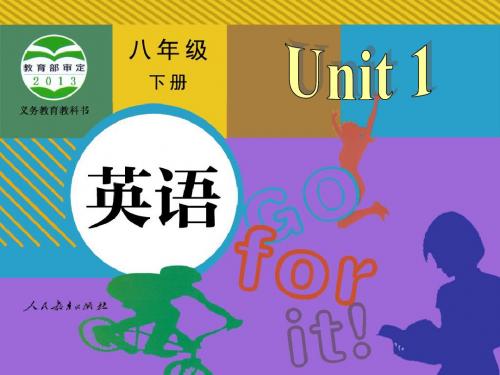
on him when he was climbing by 4________ himself in the mountains. Because he could not free his arm, he stayed there for five days and hoped that 5_________ someone would find him. But when his water ran 6____, out he knew that he would have to do something to 7_____ save his own life. He was not ready to die that day. So he used his
5. When you have a stomachache, please lie l___ down and rest r____. 6. I get o____ at the next station. off 7. He h____ hurt his knee, I should put a bandage on it. 7. Aron almost lost his life because of a________. accident 9. Their water r___ ran out.
I have a toothache.
You should see a dentist and get an X-ray.
Are you OK?
I didn’t wear enough warm clothes yesterday. Now I have a cough. You should drink some hot tea.
(完整版)八年级下unit1SectionA3a-3c教学设计

Watch the video together.
Students guess what word it is
Read together and find the answers.
Read the passsage and answer the questions.
布置作业
1分钟
1)Finish 4b on page 4,trying not to refer to the passage you learned in this class.
2)Repeatthe article.
板书设计
1)new words:
Passegeer ,bandage ,trouble, get off.
Do you like to watch the sketch? Let’s watch the sketch first.
What would you do if you met someone who fell on the road or had an accident,what you will do?
2)Important phrases:
Without+动ing,see+动ing
教学反思
1由于时间短的关系,很多学生没有得到发言和表演的机会,小组竞赛也没进行到底,很多学生意犹未尽。表演的孩子使用了丰富的表情与体态语,使语言更加真实。以后要多鼓励学生,大胆展示自己。2.提高自身的英语素质水平是要努力加油的,我觉得自己表扬学生的语句还要丰富些,对于课堂上的一些课堂用语,我还要继续加油,在平时教学中多运用,达到熟能生巧。3.在小组活动上应该再加强,放手给孩子更多的空间,预设学生说的环节,因为怕时间不够,由我代劳了,应该相信孩子会做到更好
八下英语Unit1_SectionA_(3a-3c)
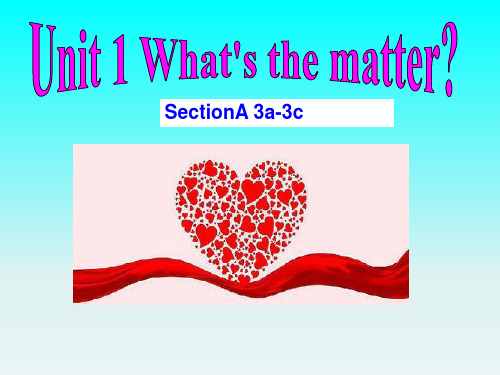
others because they don’t want any trouble, "says one passenger. “But
the driver didn’t _____t_h_i_n_k__a_bhoimutself. He only thought about
At 9:00 a.m.yesterday,bus No.26 was going along Zhonghua
Road when the driver _s_a_w__a_n__o_l_d__m__a_n__ly_i_nogn the side of the road. A woman next to him was ___s_h_o__u_t_in_g__f_o_r__h.elp
Bus Driver and Passengers Save an Old Man
At 9:00 a.m.yesterday,bus No.26 was going along Zhonghua
Road when the driver saw an old man lying on the side of the road. A
Thanks to Mr. Wang and the passengers, the man was saved by
the doctors in time. “It’s sad that many people don’t want to help
others because they don’t want any trouble, "says one passenger. “But
- 1、下载文档前请自行甄别文档内容的完整性,平台不提供额外的编辑、内容补充、找答案等附加服务。
- 2、"仅部分预览"的文档,不可在线预览部分如存在完整性等问题,可反馈申请退款(可完整预览的文档不适用该条件!)。
- 3、如文档侵犯您的权益,请联系客服反馈,我们会尽快为您处理(人工客服工作时间:9:00-18:30)。
S. cut myself
e. put some medicine on it
2c Make conversations using the information in 2a and 2b.
总结:have 表示“得„病”; Health’s problems: 结构为“have a +疾病名称”
have a cold have a fever have a cough have a sore back have a sore throat have a sore neck. have a headache have a stomachache have a toothache
(请加上你个性化的动作哦)
A: What’s the matter with you ?
B:I have a …
A: What’s the matter with him/her? B: He/She has a…
I’ll give you some advice.
Advice
I have a toothache. You should see a dentist.看牙医
句型转换: 1.I have a headache.((划线部分提问) What’s _____ wrong _____ with you? 2.What’s wrong with you ? (改成同义句) _____ _____ What’s the ______ matter with you ? 3.Sarah had a cold last week ? (改成一般疑问句) Did Sarah ______ have a cold last week ? ______ 4.should, you, see, a, dentist(连成一句) You should see a dentist. ____________________________________
单项选择
(1) -- I have a sore back. C down and rest. -- You should ______ A. to lie B. lying C. lie D. lied B cold? (2) – Did you catch ____ --Yes , I had_____ bad cold. A. the , a B. a , a C. a , the D. the , the C (3)—what’s ____with you? A. matter B. the wrong. C. the matter D. trouble
2d Role-play the conversation
• • • • • • • • • • • • Mandy: Lisa, are you OK? Lisa: I have a headache and I can’t move my neck. What should I do? Should I take my temperature? Mandy: It doesn’t sound like you have a fever. What did you do on the weekend? Lisa: I played computer games all weekend. Mandy: That’s probably why. You need to take breaks away from the computer. Lisa: Yeah, I think I sat in the same way for too long without moving. Mandy: I think you should lie down and rest. If your head and neck still hurt tomorrow, then go to a doctor. Lisa: OK. Thanks, Mandy.
2
4
3
1
5
2b Listen again. Match the problems with the advice.
1. fever a. lie down and rest
2.stomachache
3. cough and sore throat 4. toothache
b. drink some hot tea with honey
What’s the matter ?你怎么了? (询问出了什么事或得了什么病) =What ‘s the trouble? =What’s wrong?
如果其后接人称代词(宾格)时,应加上 介词with.如 What’s the matter with her?
What’s the matter?
I have a stomachache.
You should lie down and rest.
I have a fever. You should drink lots of water.
2a Listen and number the pictures [1-5] in the order you hear them.
翻译短语: 1.躺下并且休息 2.喝热蜂蜜茶 3.嗓子疼、 4.发烧、 5.喝大量水、 6.看牙医
1.lie down and rest 2.drink hot tea with honey 3.have a sore throat 4.have a fever 5.drink lots of water 6.see a dentist
Period1(1a—2c)
Where is his neck? ear face
head
eye nose mouth
arm
hand
tooth(teeth)
back
leg
stomach foot
In fact, Mr Pan didn’t feel well when I met him. Do you know what’s the matter with him?
A: What's the matter? B: My head feels very hot. A: Maybe you have a fever… B: …
Listen to the tape and answer the following questions. 2d
• 1. What’s the matter with Lisa? • 2. What did Lisa do on the weekend? • 3. what should Lisa do?
名词后缀-ache 表示部位疼痛
1b Listen and look at the picture. Then number names [ 1-5]. 2 4 Sarah __1__David ________ Nancy _____
3 Ben______ 5 Judy_____
Work in pair
I have a fever(发烧) I have a cold(感冒) I have a sore back(背痛)
I have a sore throat(喉咙痛)
What’s the matter?
I have a headache(头痛)
I have a stomachache(胃痛)
I have a toothache(牙痛)
